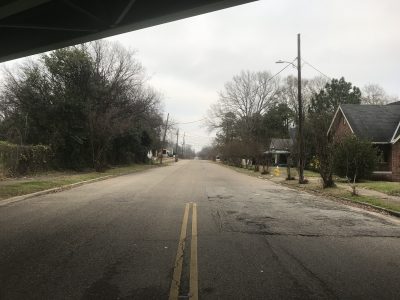By Rebecca Retzlaff. For this month’s theme of sustainability goal 8: decent work and economic growth, I want to focus on transportation equity, an often-overlooked, but nonetheless essential, component of working and economic growth. A few years ago, my historic preservation planning class (CPLN 5400/6400) was working on a historic preservation plan for the Peacock Place neighborhood in Montgomery. The project was part of the Alabama City Year Program, spearheaded by Auburn’s Community Planning Program, which provides urban planning assistance to communities in need throughout Alabama. As part of the project, the class took a tour of the neighborhood led by a city planner in Montgomery and the pastor of the Mount Zion AME Church, located in the neighborhood. The church has an important history – it was where the Montgomery Improvement Association formed, it was a meeting place during the Montgomery Bus Boycott, and it provided food and shelter to people during the Selma to Montgomery March. The I-85/I-65 interchange is right next to the church. As the class walked under the overpass to the other side of the neighborhood that was sliced in half when the highway was built, the church pastor described the disastrous effect that the highway had on the neighborhood. He also noted that the highway was designed to do as much destruction as possible to the African American families that were active in the civil rights movement.
A few years later, I had the opportunity to take a semester-long research sabbatical. When I was trying to think of a new research project to work on, the pastor’s story about the highway in Montgomery came to mind. In my field, urban planning, it is common knowledge that the interstate highways were routed through African American and minority neighborhoods. I decided to try to uncover the details of the story as the focus of my sabbatical research. I learned that there is evidence to suggest that civil rights activists were perhaps on the mind of highway engineers and that civil rights activists did believe that their homes were targeted as punishment for their civil rights activism and voting.
Since learning more about interstate highway routing in Alabama and throughout the U.S., I cannot drive down a highway without wondering about the people of color, neighborhoods, and businesses that were destroyed in the name of urban planning and engineering ‘progress,’ economic growth, and efficiency. A transportation system that destroys neighborhoods is not sustainable, and sustainable transportation systems need to be less car-centric and more equitable in order to meet the sustainability goal of providing decent work and economic growth for all. It also needs to be anti-racist and right the wrongs that harm neighborhoods today.

A neighborhood off of the highway in Montgomery (photograph by Vincent Hall)
The last few months have created a lot of optimism among advocates of sustainable transportation equity. Planners and advocates have developed proposals to remove highways or convert them to tunnels in New Orleans, Austin, Denver, Oakland, Chicago, Tampa, and other cities. Last spring, as newspaper headlines featured calls to take down confederate and racist monuments throughout the country, sustainable transportation advocates pointed out that interstate highways are also enduring monuments to racism. In December, nominee for
Transportation Secretary Pete Buttigieg pledged to reverse decades of discriminatory urban planning by dismantling highways that were routed through African American neighborhoods, noting, “black and brown neighborhoods have been disproportionately divided by highway projects or left isolated by the lack of transit and transportation resources. In the Biden-Harris administration, we will make right these wrongs an imperative.” In January, a group of 25 Senators introduced a bill in the U.S. Senate that includes a $10-billion program to deconstruct urban highways and rebuild the neighborhoods that were destroyed. Importantly, it included funds for community engagement, anti-gentrification, and local capacity building, which were left out of the Highway Act of 1956 that funded many of America’s highways. While the proposal may not go anywhere, the idea that elected leaders are paying attention to sustainable community transportation systems, to work toward sustainable economic growth and jobs, is encouraging. I am especially hopeful given the fact that many elected leaders view infrastructure funding as a way to create jobs in our post-pandemic future. I hope that it is sustainable and equitable infrastructure that they have in mind. In the meantime, I will be dreaming about all of the sustainable ways that cities could use the acres and acres of land currently occupied by highways.
Post contributed by Rebecca Retzlaff, Associate Professor, Community Planning Program, Department of Political Science. Photograph by Vincent Hall.
Learn about the SDGs & AU and our contributions related to this post.







